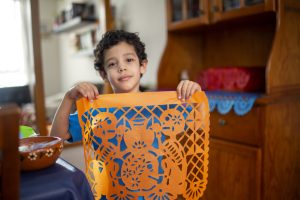- Having brief conversations about math as part of everyday family activities may promote children’s mathematical thinking and learning.
- Find ideas for talking about math in these videos showing families grocery shopping, setting the table, and doing the bedtime routine.
If you are searching for ways to get children engaged in math, look no further than your everyday family routines. Instead of aiming to set aside time for one more thing to do, caregivers can find meaningful early math learning opportunities hidden in activities they are already doing with their children.
Where is math hidden? One place is in daily life routines. For example, math can be found while preparing meals, going for walks, doing laundry, gardening, getting ready for bed, playing games, or grocery shopping.
Notice and Talk About Math Together
Parents and caregivers can take advantage of hidden math to expand their children’s math skills without it feeling like a formal math lesson. We propose these four steps for informal, engaging conversations around math (the steps are also available in Spanish):
- Notice the math.
- Talk about the math.
- Ask questions and have conversations.
- Model and praise problem-solving.
The first step involves caregivers becoming aware of the math around them. This includes noticing opportunities to use math and noticing when children are already thinking mathematically. These opportunities could be when your family is:
- Counting objects.
- Adding, subtracting, or comparing quantities.
- Comparing shapes, sizes, or positions of things.
- Noticing patterns or sequences in objects or events.
- Measuring things or distances.
Once a caregiver has noticed the math, they can talk about the math by sharing comments, asking questions, and having conversations that reveal the usefulness of mathematics. For example:
- “Do we have enough napkins for everyone who will be at the dinner table?”
- “I wonder which of these grocery checkout lines will be the fastest?”
- “How many stuffed animals can fit on your pillow next to you?”
- “Look to see if there are cards on your game board that fill a row. The row can go across, down, or diagonally.”
- “We need five quarters to run this washing machine. I took these two quarters out of my change purse. Please help me find more quarters and figure out how many more quarters we need.”
By asking questions like these, caregivers start conversations that prompt children’s mathematical thinking to solve problems meaningful to them.
Noticing the math means not only noticing when children are thinking mathematically, but also commenting on children’s thinking and praising children’s attempts or success at problem-solving. For example:
- When children notice, “Hey, there are only four napkins, but there are six people eating, so we need two more napkins,” caregivers can praise problem-solving by simply saying, “You figured that out!”
- When children observe which of several grocery store checkout lines is the shortest, caregivers can reinforce: “Yes, it has the fewest people, so it might be the fastest one to get through.”
- When children try to fit one too many stuffed animals onto their pillow at bedtime and then remove one, caregivers can recognize the strategy: “Right, that one did not fit on the pillow with the others!”
- When children realize they have a winning game board and call out, “I have four in a row!” caregivers can excitedly agree: “You win! You have four in a row, going across.”
- When children correctly count out how many quarters are needed for the next load of laundry, caregivers can praise the child’s problem-solving process: “Nice, that’s enough quarters to make the machine work!”
Examples of Math in Everyday Life
These brief videos are examples of the kinds of math conversations that families can have while going about daily routines like setting the table, getting ready for bed, and grocery shopping.
Professionals who work with families can use these videos to inspire caregivers to notice, talk about, and encourage math learning opportunities with their children, while also acknowledging caregivers’ different ideas for incorporating math into everyday family life. After watching the videos, think about what math conversations are possible in your family’s everyday routines!



